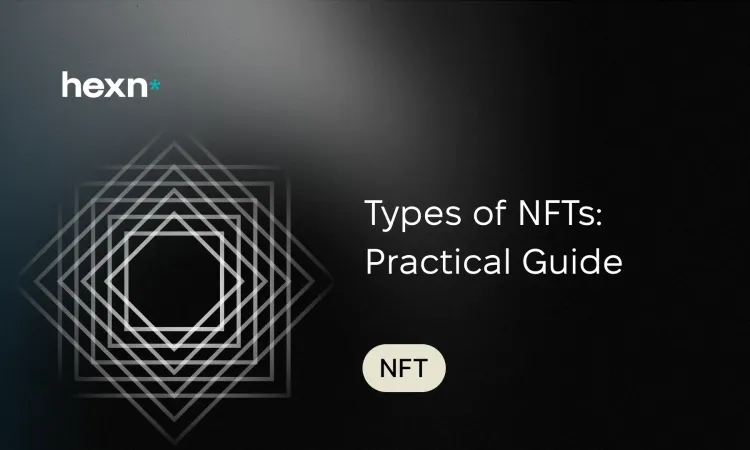Types of NFTs: Practical Guide
What Is an NFT?
An NFT, or non-fungible token, is a unique digital record on a blockchain that proves ownership and provenance of a specific item, file, or right. Unlike interchangeable cryptocurrencies, each NFT is distinct. This uniqueness allows creators, collectors, and businesses to attach scarcity, authenticity, and programmable rules to digital content, opening new ways to buy, sell, and manage value online.
How NFTs Work
NFTs are minted using smart contracts that write a token's metadata and ownership history to a distributed ledger. That on-chain record makes transfers transparent and verifiable. For creators, NFTs provide new revenue channels and built-in royalty mechanisms; for buyers, they offer a way to hold provable, transferable digital assets. While the concept is simple, the implications touch art, gaming, identity, licensing, and digital commerce.
Common Ways to Categorize NFTs
One practical way to understand the NFT ecosystem is to group tokens by their primary use. Below are common categories that reflect how people actually use NFTs today.
Profile Picture Collections and Social Identity
Some NFT projects function as recognizable digital avatars or status markers used across social platforms and communities. These collections often build identity, membership, and social signals—holders may access gated communities or exclusive events tied to owning a specific token.
Digital Art and Visual Media
Digital art remains one of the most visible NFT use cases. Artists can tokenize illustrations, animations, and multimedia pieces to prove provenance, sell editions, and receive resale royalties. This format reshapes how visual creators monetize and distribute work.
Music, Audio, and Creative Content
Musicians and audio producers use NFTs to sell tracks, albums, limited releases, or exclusive material directly to fans. NFTs can embed royalty logic so creators receive a percentage of future sales.
In-Game Items and Virtual Goods
Gaming NFTs represent items such as skins, weapons, or avatars that players can own, trade, or carry between compatible environments. These tokens can enable true player ownership and secondary markets for digital goods.
Virtual Real Estate and Online Spaces
Parcels of virtual land, digital storefronts, and event spaces are often issued as NFTs. Owners can develop, lease, or monetize these virtual properties within online worlds and platforms.
Utility NFTs for Access and Perks
Utility NFTs act as keys to services, memberships, tickets, or product drops. Their value comes from the benefits they unlock rather than purely collectible attributes.
Digital Identity and Credentials
Some NFTs are designed to represent identity data, certifications, or reputation. By decentralizing identity verification, these tokens aim to give people more control over personal data and credentials.
Other Creative and Niche Uses
Video, photography, fashion, domain names, literature, and sports memorabilia are also common NFT formats. New applications continue to appear as creators experiment with tokenized rights and experiences.
How Interactivity Changes the Type of an NFT
Not all NFTs are static images. Interactivity and data inputs create different classes that affect value and use.
Static NFTs
These tokens link to immutable media such as a JPG or a fixed animation. The asset does not change after minting, and ownership is the primary feature.
Dynamic NFTs that Evolve Over Time
Dynamic NFTs update their metadata or visual traits in response to external inputs like time, user actions, or data feeds. This makes them useful for games, evolving collectibles, or real-world event tracking.
Interactive NFTs with Built-In User Engagement
Interactive NFTs allow direct interaction—owners can modify attributes, participate in gameplay, or trigger behaviors tied to the token. They blur the line between asset and application.
Token Standards and Networks that Support NFTs
NFT behavior is shaped by token standards and the blockchains that host them. These standards define how tokens are issued, transferred, and recognized by wallets and marketplaces.
ERC-721 and Single-Token Uniqueness
The most common standard for one-of-a-kind tokens defines unique ID numbers and ownership rules. It lets each token be independently tracked and traded.
ERC-1155 and Multi-Type Token Contracts
Some standards support both fungible and non-fungible items within a single contract, which can be more efficient for games and platforms that manage many asset types.
Alternative Blockchains and Scaling Options
Beyond the most widely used networks, several blockchains offer their own NFT formats to reduce fees, increase throughput, or provide specific features. Choosing a network often involves trade-offs around cost, speed, and ecosystem compatibility.
Licensing Categories
Owning an NFT does not automatically grant all rights to the underlying work. Licensing determines what buyers may legally do with the asset.
- Open licensing: Owners receive broad permissions to display, remix, or build on an asset. This approach encourages sharing and derivative work.
- Closed licensing: Usage is tightly controlled by the creator. Owners can trade the token but have limited or no commercial rights to the content.
- Partial licensing: A middle ground where holders get specific, restricted rights—for example, noncommercial display or limited commercial use under defined conditions.
Creators should state licensing terms clearly at minting, and buyers should review rights before purchasing to avoid misunderstandings.
Key Takeaways
NFTs are a flexible way to represent unique digital items, and their classifications help make sense of the growing market. Think about three practical considerations before engaging with NFTs:
- Purpose: Are you buying for collectibility, utility, or access? Different goals suggest different types of tokens.
- Interactivity and standards: Dynamic or interactive NFTs require compatible platforms; token standards affect transferability and cost.
- Licensing and rights: Verify what you are permitted to do with the content—resale rights do not always equal commercial rights.
As the space evolves, new categories and hybrid models will appear. Staying informed and cautious helps both creators and collectors benefit while managing the risks of an emerging market.
